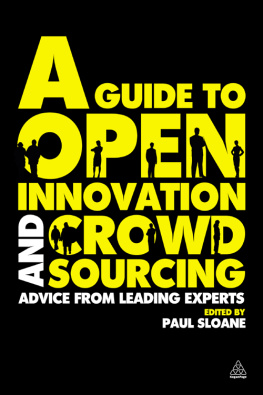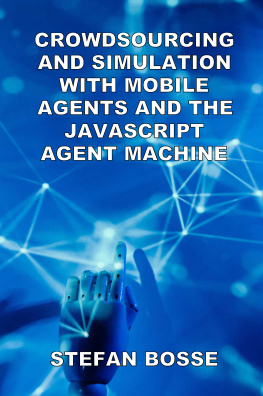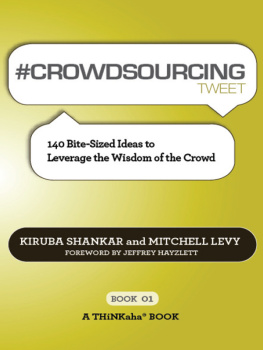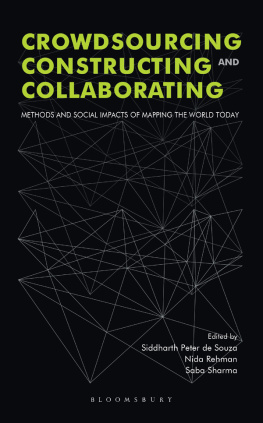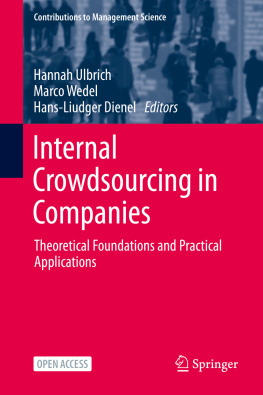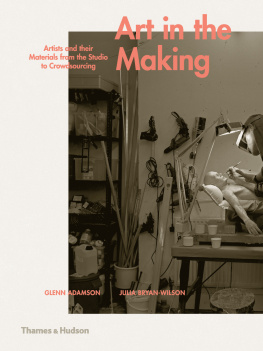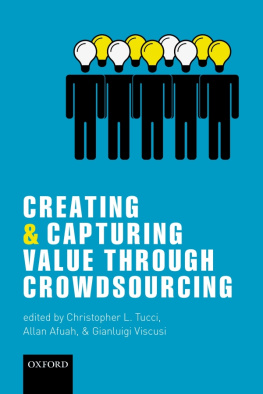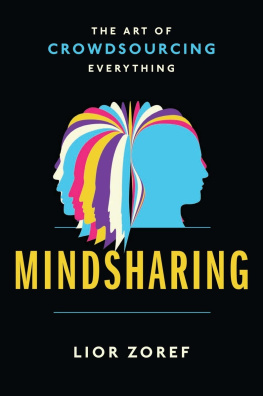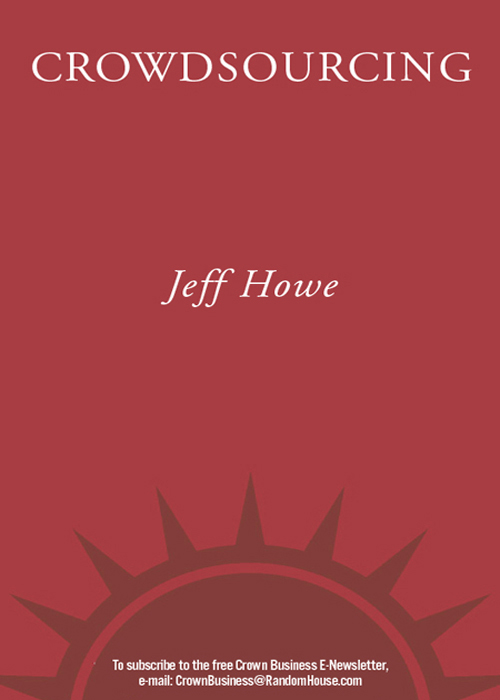
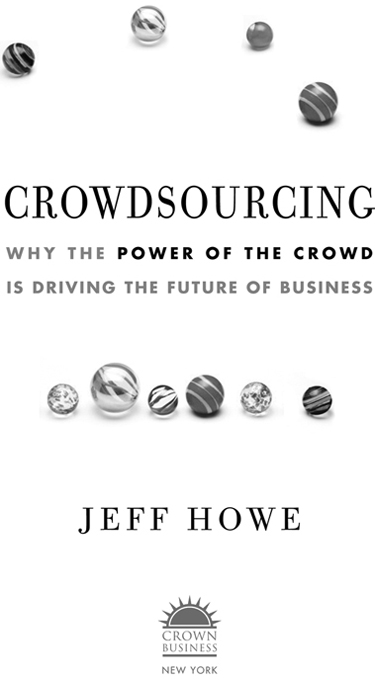
CROWDSOURCING
CONTENTS
To Alysia and our very small crowd
INTRODUCTION
The Dawn of the Human Network
The Jakes didnt set out to democratize the world of graphic design; they just wanted to make cool T-shirts. In 2000, DeHart, as theyre more formally known, were college dropouts living in Chicago, though neither had found much work putting his abbreviated educations to use. Both were avid members of a burgeoning subculture that treated the lowly T-shirt as a canvas for visual flights of fancy. So when they met after entering an online T-shirt design competition, they already had a lot in common. For starters, both thought it would be a good idea to start their own design competition. But instead of using a jury, they would let the designers themselves pick the winner. That November a company was bornthe product of equal parts youthful idealism and liberal doses of beer.
The pair launched Threadless.com a few months later with a business plan that was still in the cocktail-napkin stage: People would submit designs for a cool T-shirt. Users would vote on which one was best. The winner would get free T-shirts bearing his or her winning design, and everyone else would get to buy the shirt. At first the Two Jakes, as people called them, ran Threadless from Nickells bedroom. But the company grew. And grew. And grew yet more. People liked voting on T-shirts, and the designs were less staid and less formulaically hip than those sold by Urban Outfitters or Old Navy. The winning designs started appearing on hit TV shows and on the backs of hip-hop artists. The company has nearly doubled its revenue every year since. Threadless currently receives some one thousand designs each week, which are voted on by the Threadless community, now six hundred thousand strong. The company then selects nine shirts from the top hundred to print. Each design sells outhardly surprising given the fact Threadless has a fine-tuned sense of consumer demand before they ever send the design to the printer.

Design by democracy, as it happens, isnt bad for the bottom line. Threadless generated $17 million in revenues in 2006 (the last year for which it has released sales figures) and by all accounts has continued its rapid rate of growth. Threadless currently sells an average of ninety thousand T-shirts a month, and the company boasts incredible profit margins, according to Jeffrey Kalmikoff, its chief creative officer. Threadless spends $5 to produce a shirt that sells for between $12 and $25. They dont need advertising or marketing budgets, as the community performs those functions admirably: designers spread the word as they try to persuade friends to vote for their designs, and Threadless rewards the community with store credit every time someone submits a photo of themselves wearing a Threadless shirt (worth $1.50) or refers a friend who buys a shirt (worth $3).
Meanwhile, the cost of the designs themselves isnt much more than a line item. DeHart and Nickell have increased the bounty paid to winning designers to $2,000 in cash and a $500 gift certificate, but this still amounts to only $1 million per year, a fraction of the companys gross income, and Threadless keeps all the intellectual property.
But as any number of winners will happily volunteer, its not about the money. Its about cred, or, to give that a more theoretical cast, its about the emerging reputation economy, where people work late into the night on one creative endeavor or another in the hope that their communitybe it fellow designers, scientists, or computer hackersacknowledge their contribution in the form of kudos and, just maybe, some measure of fame. Threadlesss best sellers (such as Communist Party, a red shirt featuring Karl Marx wearing a lampshade on his head) are on regular view at coffee shops and nightclubs from London to Los Angeles.

The Jakes now enjoy a certain degree of notoriety themselves. Nickell and DeHart have become heroes among the do-it-yourself designer set, and even have given lectures to MBA students at MITs Sloan School of Management. Aspiring executives spent much of the time explaining all the basic business tenets the Jakes had broken in building Threadless. Good thing they werent there when Nickell and DeHart were first launching their company. Nickell and DeHart are smart enough to know a good idea when they stumble on it. They created a parent company, skinnyCorp, which includes not just Threadless but a spin-off division that takes a similarly democratic approach to the creation of everything from sweaters to tote bags to bed linens. Next were thinking of doing housewares, says Nickell.
An Accidental Economy
In late 2005, the Pew Internet & American Life Project released a paper called Teen Content Creators and Consumers. The study, which consisted of interviews with more than eleven hundred Americans between the ages of twelve and seventeen, drew little attention when it was published, but the findings were extraordinary: there were more teens creating content for the Internet than there were teens merely consuming it. At the time it was commonly assumed that television had created a generation of consumers characterized by unprecedented passivity. Yet now it seemed the very opposite was the case. In his book The Third Wave the futurist Alvin Toffler predicted that consumers would come to exercise much more control over the creation of the products they consumed, becoming, in a word, prosumers. In 1980, the year Toffler published his book, this seemed like mere fodder for bad science-fiction novels. From the perspective of 2005, it seemed stunningly prescient.
Pews conclusions confirmed my own recent experience. A few months before the study was released I had been hopscotching across the country attending concerts on the Warped Tour, a carniesque collection of punk bands and the hangers-on that followed them from town to town. I was writing about the social networking site MySpace, which was knownto the degree it was known at allas a grassroots-marketing venue for Emo bands, off-color comedians, and Gen Y models. In the hours I spent with the performers and their fans, I noticed that very few defined themselves as musicians, artists, or any other such label. The singers were publishing books of poetry; drummers were budding video directors; and the roadies doubled as record producers. Everythingeven one musicians pencil portraitswas posted to the Internet with minimal attention to production quality. These were what Marc Prensky, a game designer and educator, calls the digital natives. The rapidly falling cost of the tools needed to produce entertainmentfrom editing software to digital video camerascombined with free distribution networks over the Web, had produced a sub-culture unlike anything previously encountered: a country within a country quite capable of entertaining itself.
Next I heard about the Converse Gallery ad campaign, in which the shoemakers ad agency solicited twenty-four-second spots from anyone capable of wielding a camcorder. The shorts had to somehow convey a passion for Chuck Taylors, but that was it. You didnt even have to show the shoe. The best of the spots were very, very goodelectric with inventive energy, yet grainy enough to look authentic, as indeed they were. Within three weeks the company had received seven hundred fifty submissions, a number that climbed into the thousands before Converse discontinued the campaign in early 2007. It was viewed as a smashing success by both the company and the advertising industry, as well as a seminal example of what is now called user-generated content.
Next page







